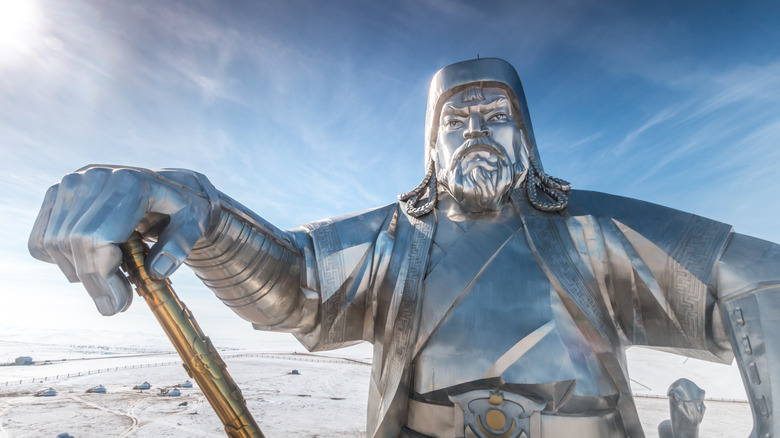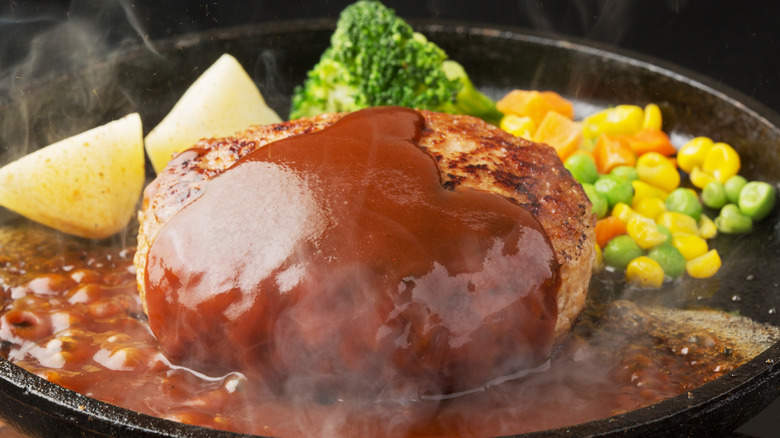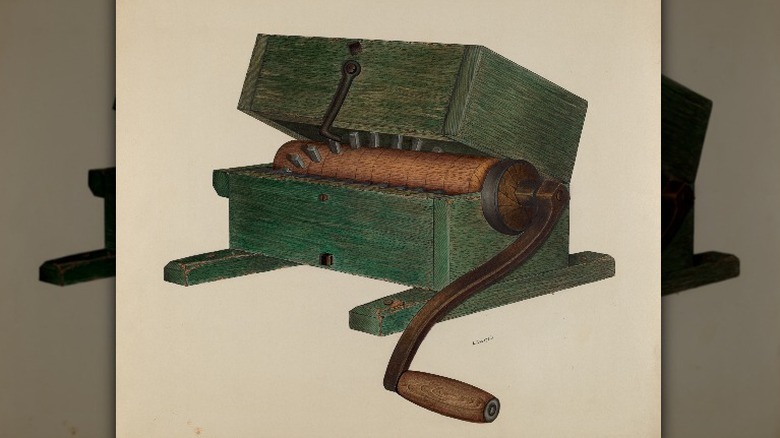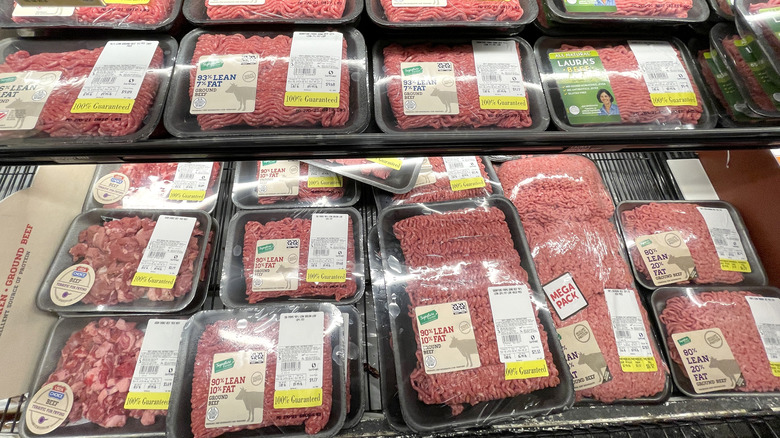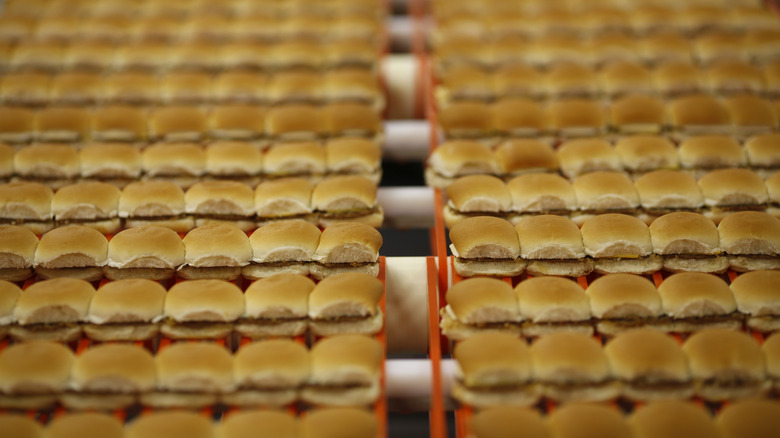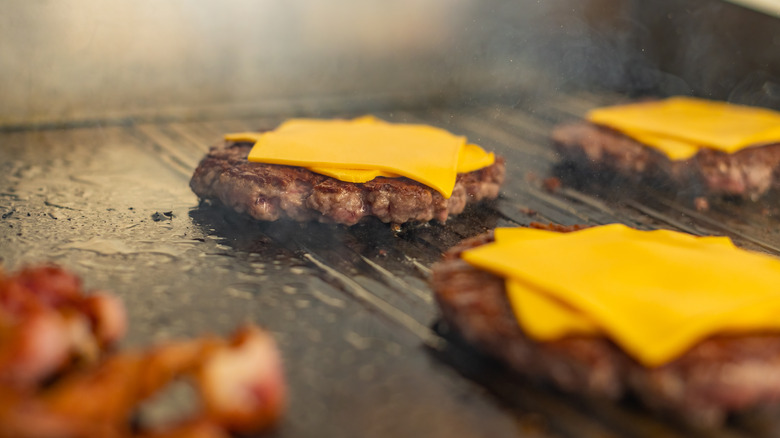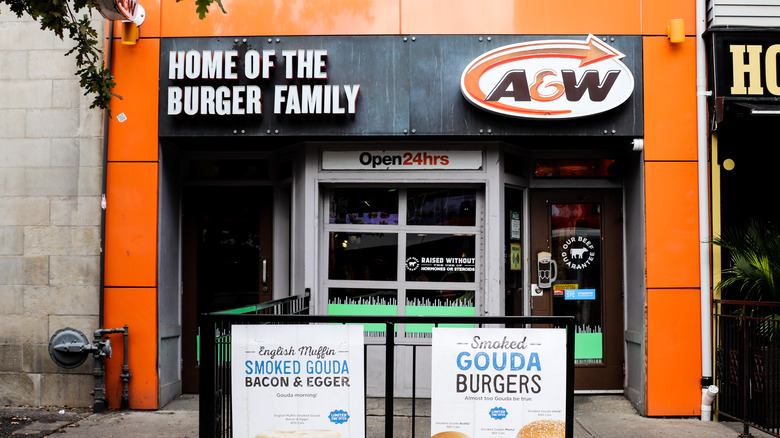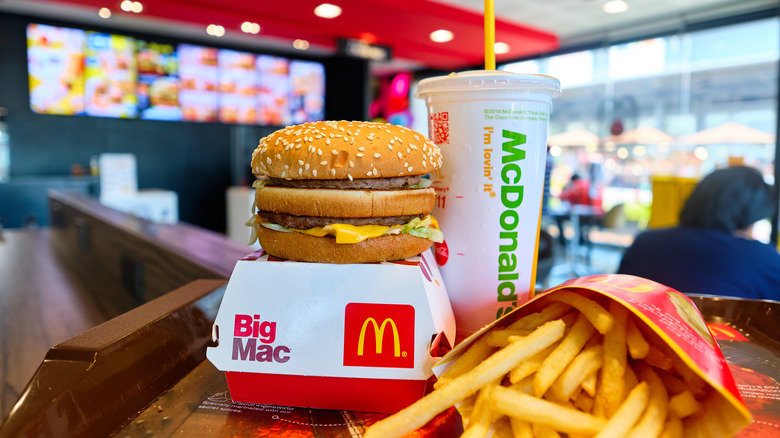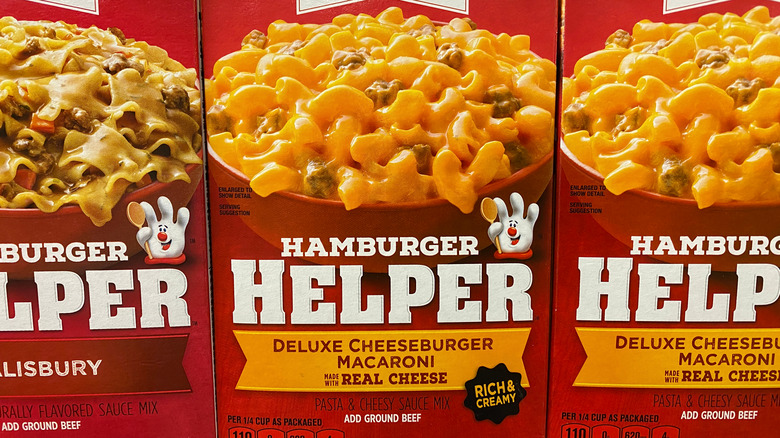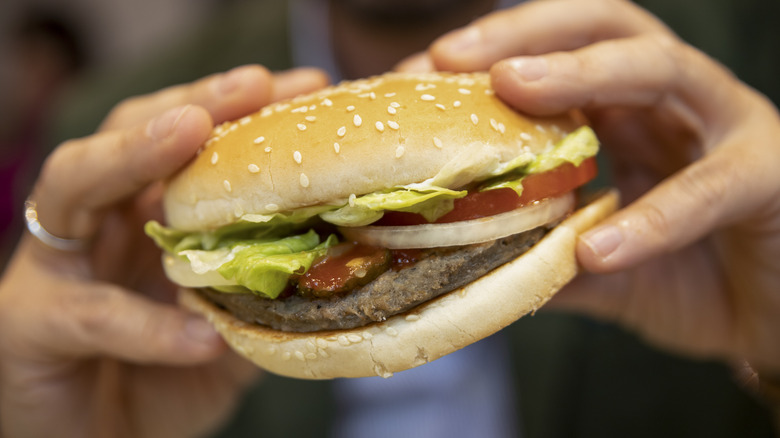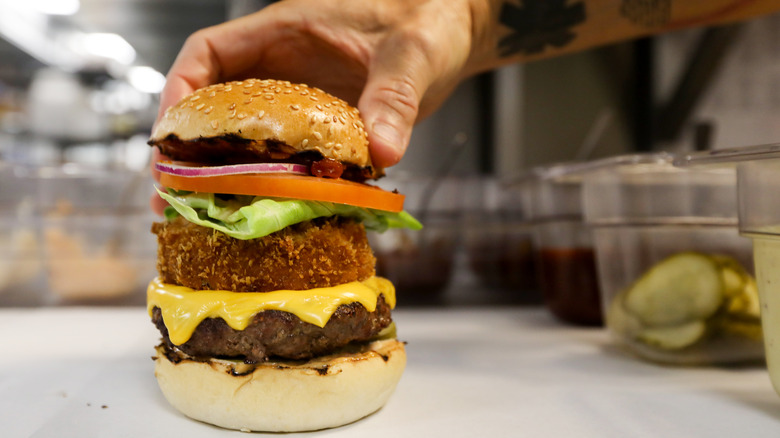The Secret History Of The First Hamburger
Americans eat a lot of meat. In fact, the U.S. Department of Agriculture estimates that Americans eat over 220 pounds of meat per year on average (via Quartz). According to USA Today, a big portion of that comes in the form of burgers, with the average American eating 156 per year, or about three per week. That may seem like a far-fetched statistic, but when you take into consideration that burgers are readily available on just about every street corner, it starts to feel a little more plausible.
So how did we get here? To eating so many burgers?
There are a lot of rumors circulating around the origin of the burger. You might've heard that burgers were first served at the Chicago World's Fair (where so many famous foods got their start). You may think it has to do with that Earl of Sandwich guy that you've heard about. However, the art of the hamburger goes much further back, all the way to the ancient Romans.
The Roman burger
According to Museum Crush, an informative website supported by Arts Council England, it was the Romans, not Ray Kroc, who first decided to chop up some beef and throw it together with other ingredients to form a patty. In a Roman cookbook dating back to the fifth century A.D., a recipe details how to make something called isicia omentata, which combined minced meat, pepper, wine, pine nuts, and a sauce into a meat patty. Similar recipes followed suit, such as Medieval and Georgian equivalents that were essentially flattened, fried meatballs.
However, while it was the Romans who likely created the first burger-esque patty, it was the famous Earl of Sandwich, in 1762, who decided to take his meat and put it between two slices of bread (via History). So, the next time you enjoy a fast-food or gourmet burger, you can thank both the Romans and the English.
Ground beef catches on
The Romans wouldn't have a true burger until someone decided to add two pieces of bread, and the Earl of Sandwich likewise would be burger-less until someone filled his bread with ground beef. Minced beef, that quintessential burger ingredient, boasts its own unique origins.
One of ground meat's first recorded mentions can be found in the histories of Genghis Khan (via What's Cooking America). In the 12th century, the emperor and his army would place lamb or mutton scrapings beneath their saddles, pulverizing it until it was ready to eat, which they did one-handed while on horseback. In the 13th century, the Russians adopted Khan's meat pulverization method, giving it a bit of an upgrade and creating steak tartare. Germans from Hamburg adopted steak tartare from the Russians and then later introduced it to the United States in the 1700s and 1800s, where it took on the name Hamburg steak.
The Hamburg steak brings us closer to the modern burger
Around this time, ground beef would be enjoyed either cooked or raw. It was usually seasoned with local spices or mixed with soaked breadcrumbs and chopped onion (in fact, the 1802 "Oxford English Dictionary" defines a Hamburg steak as minced, salted beef that's smoked and mixed with onions and breadcrumbs). One of the oldest written references to the "Hamburg sausage" is in a 1763 English cookbook, "The Art of Cookery, Made Plain and Easy." In this cookbook, Culture Trip reports, minced beef is blended with suet, pepper, cloves, nutmeg, garlic, salt, wine, and rum, making a mixture not so different from what the Romans were doing centuries before.
The Hamburg steak was on New York City menus by 1837 as an affordable snack for the impoverished masses (via The Guardian). Still, even as ground beef became more and more popular and diners began to acknowledge the burger patty as an affordable and convenient meal, it wasn't yet the norm to place that patty between two slices of bread.
American industry makes ground beef even more accessible
Maybe the only thing slowing down the ascension of the burger was its time-consuming preparation. After all, not everyone had the time to chop up fresh beef for a quick serving of steak tartare, nor did they want to simply let their horse do the work for them, sliding their beef beneath their saddle Genghis Khan-style. The invention of industrial-style meat grinders and choppers made ground hamburger much more accessible and popular.
According to What's Cooking America, the first patents for mechanical meat choppers were filed in the early to mid-1800s. An 1829 patent described a meat cutter that used choppers that would move up and down a rotating block, while an 1845 patent used a spiral feeder and rotating knives to create a contraption somewhat reminiscent of today's blenders. These types of devices made it easy for not only restaurants but also home cooks to more efficiently grind beef or another meat of their choice.
Ground beef — It's what's for dinner
Ground beef — cooked both Hamburg-style and otherwise — swept across the United States throughout the 1800s. In 1867, a doctor in New York, James H. Salisbury, recommended that his patients eat cooked ground beef patties for their digestive health, creating the Salisbury steak (via History). In 1871, Hamburg beefsteak could be found on lunch menus in California at the cost of just $0.10 per meal. At the 1904 St. Louis World's Fair, hamburger steak, both plain and served with onions, was available at the Tyrolean Alps Restaurant (via What's Cooking America).
And as for that rumor that the famous New York City restaurant Delmonico's was the first restaurant in the country to offer a hamburger? That, as What's Cooking America reports, is just a rumor. A supposed 1834 printed menu from the restaurant shows hamburger steaks listed for $0.10 each, but historians have since found that the menu is an impossibility, as the restaurant's printer was not in business in 1834.
But where's the bread?
By the turn of the 20th century, you could find ground beef all over the country, and someone finally had the inventive idea to slide that ground beef between two slices of bread. As for who that person was, however, it's a matter of much debate.
Some claim a Texas man named Fletcher Davis sold cooked beef patties on bread in Athens, Texas, as early as the 1880s. According to that story, he took that dish to the St. Louis World's Fair in 1904, where the idea spread. Some claim that the original creator was a Connecticut man, Louis Lassen, who invented the hamburger in 1900; Lassen's descendants say that their family restaurant served up ground beef scraps on slices of bread at the turn of the century (via ABC News). Others say that in 1885, a man named Hamburger Charlie created a burger at a county fair in Wisconsin after failing to sell his meatballs. Yet another story claims that two brothers invented the burger in Hamburg, New York, at a separate county fair in the same year (via Culture Trip).
If all of the above sources are telling the truth, then Fletcher Davis would be the original creator, as his story predates the other origin myths.
The hamburger bun comes on the scene
One thing's for sure: We might not know for sure who created the hamburger, but we do know exactly who created the hamburger bun. While all the above men were slapping their ground beef burgers between ordinary pieces of bread, it was Walter Anderson who created the hamburger bun in 1916 (via Culture Trip). Anderson was onto something with his bun, too, because he changed the landscape of the hamburger in more ways than one. According to the Kansas Historical Society, after creating a bun to go along with the burgers that he sold from a simple street cart in Wichita, Kansas, Anderson founded White Castle in 1921 along with E.W. Ingram. White Castle is known as the very first and longest-standing hamburger chain in the United States.
While this version of the hamburger was a long time coming, once this type of burger got its start, it rapidly continued evolving throughout the 20th century.
The first cheeseburger
The first cheeseburger came not long after the modern hamburger, but just like with the hamburger, the question of who exactly invented the first cheeseburger is up for debate. According to The Spruce Eats, some food historians say the inventor was Lionel Sternberger, who added a slice of American cheese to a cooking hamburger at his dad's sandwich shop. He liked this "cheese hamburger," as he and his dad called it, so they started offering it at the shop in 1924.
Others, however, say that a Louisville, Kentucky, restaurant invented the cheeseburger, adding it to their menu in 1934 with the actual name "cheeseburger" versus Sternberger's "cheese hamburger." Another account claims that the inventor was Louis Ballast of Denver, who actually trademarked the word "cheeseburger" in 1935. Regardless of who the actual cheeseburger inventor was, by the time the 1940s rolled around it was not at all uncommon to find your burger topped with a slice of American cheese.
The first bacon cheeseburger
Everyone knows that the best way to improve anything with cheese is to add bacon. Unfortunately, it took a few decades for someone to get the bright idea to add bacon to their cheeseburger, at least on any sort of national scale.
The story goes that Dale Mulder, Michigan A&W owner, became the first person to offer bacon cheeseburgers on a restaurant menu when he debuted them in 1963. Thrillist notes that, while this seems like it would be too late in the game for someone to finally offer a bacon cheeseburger, the addition was reported in the local news in the 1960s. In 2014 A&W even ran an ad campaign boasting about the chain's status as the inventor of the bacon cheeseburger. As for the specifics surrounding the invention, tales differ. Thrillist reports that A&W's repeat customers continuously asked for bacon slices to be added to their burgers, prompting Mulder to add the option to the menu permanently. Click On Detroit, meanwhile, says that Mulder came up with the idea all on his own and quotes him as saying, "I thought it absolutely [would] be better with bacon ... A bacon burger became a big item in the restaurant business, and everyone else stole it from us."
The world's most famous burger
In 1967, not long after A&W invented the bacon cheeseburger, the Big Mac, arguably the world's most famous hamburger, came on the scene. Jim Delligatti, a McDonald's franchisee outside of Pittsburgh, created the burger in an effort to grow business, according to his Washington Post obituary. At first, Delligatti was met with resistance, as the McDonald's powers that be were wary to mess with their success selling a simple menu of burgers, fries, and milkshakes. However, the burger managed to increase profits at its first test location by 12%, so the Big Mac rolled out nationwide in 1968.
According to Reader's Digest, the burger's success can be partially credited to Delligatti's blue-collar clientele, who wanted something a little bit heartier to fill them up after working long days at Pennsylvania steel mills. Today, the Big Mac is McDonald's second best-selling item, only surpassed by the french fry.
Going back to the basics
Although the Big Mac added complexity to the formula, America wasn't quite ready to let go of the hamburger's simple ground beef roots. After all, while Big Macs, White Castle sliders, and A&W bacon cheeseburgers are all delicious in their own rights, there's still something to be said for those simple ground beef dishes that started it all, from Salisbury steak to steak tartare.
Recognizing this, General Mills introduced Hamburger Helper in the 1970s, aiming to help American families put together a ground beef-based dinner with only a single pound of meat. As a prior Mashed article notes, this use of less beef overall was an important part of the brand's strategy, as meat prices were soaring at the time. Just like in the 1800s, families began to look to ground beef dishes for an affordable dinner solution. Hamburger Helper was an instant success, and nearly 30% of all U.S. households purchased Hamburger Helper within the brand's first year of existence.
A burger — but lose the beef?
Changing tastes would further evolve the burger beyond its beef-based iterations when the veggie burger when mainstream in 1982. The first veggie burgers, though, as Smithsonian Magazine reports, were a far cry from today's frozen veggie patties.
Developed by The Realeat Company and christened the VegeBurger, the veggie burger's first foray into the commercial food world was sold as a packet of dried food (a mixture of gluten, sesame, soy, oats, herbs, tomatoes, and onion) that buyers needed to rehydrate, form into patties, and cook. The VegeBurger product was cheaper than beef burgers and quite successful — so much so that a frozen VegeBurger debuted in 1984. Other brands quickly followed suit, including Gardenburger and Boca Burger. Now, you can find meatless burgers at just about every major fast-food chain thanks to internationally-recognized options like the Beyond Meat burger and the Impossible Burger — a change that's not only lauded as a healthier alternative but also as an option that's better for the environment.
The most recent iteration of the burger
Burgers continue to evolve, with new trends popping up regularly. The latest? The gourmet burger fad. But don't think you need to go to a fancy restaurant to find a gourmet burger.
According to Contexts: Understanding People in their Social Worlds, a quarterly, peer-reviewed academic journal and an official publication of the American Sociological Association, you can find gourmet burgers at such popular spots as Smashburger, TGI Friday's, and even In-N-Out. The journal lists the top fastest-growing "better burger" chains as Shake Shack, Smashburger, Mooyah, and Five Guys, and notes a gourmet burger can be one that simply features high-quality ingredients, such as premium beef and heirloom tomatoes, or one that features more unusual items, like pork belly or peanut butter. For foodie consumers, gourmet burgers are exotic and/or authentic, allowing them to enjoy a typically low-brow food item in a high-brow, high-culture way. It's the best of both worlds, and a trendy way to show off your good taste in food.
Whatever type of burger you prefer, though, from the humble White Castle slider that started it all, to the trendiest burger on social media, one thing's for sure: The burger may continue to evolve, but it's here for good.


